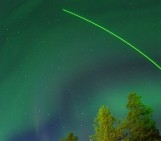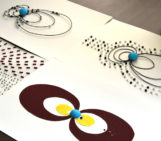When the public think about natural hazards, space weather is not the first thing to come to mind. Yet, though uncommon, extreme space weather events can have an economic impact similar to that of large floods or earthquakes. Although there have been efforts across various sectors of society to communicate this topic, many people are still quite confused about it, having only a limited understanding of the relevance of space weather in their daily lives. As such, it is crucial to properly communicate this topic to a variety of audiences. This article explores why we should communicate space weather research, how it can be framed for different audiences and how researchers, science communicators, policy makers and the public can raise awareness of the topic.
Introduction
As you sit reading this article, the Sun is brimming with activity. The yellow disc in the sky may appear unimpressive but when looking in the extreme ultraviolet region of the spectrum, the Sun’s hot active regions glow bright (Figure 1). These are areas with an especially strong magnetic field — manifested in the form of dark patches or sunspots on the solar surface — that can be the source of explosive bursts of energy and solar material. Even though the Sun is some 150 million kilometres away, these solar storms can alter the near-Earth space environment, changing our space weather.
Of the solar storms that can hit the Earth, the most damaging are coronal mass ejections. These high-speed bursts of solar material — if powerful enough and directed towards our planet with the proper orientation of their magnetic field — can disturb the Earth’s magnetic field, creating a geomagnetic storm. This can impact power grids and pipelines, and affect communications and transportation systems. Coronal mass ejections and other solar storms such as solar flares — outbursts of radiation and high-energy particles — can also affect spacecraft and satellites and even be a radiation hazard for astronauts and air crews flying at high latitudes and altitudes.

Figure 1. The Sun in the extreme ultraviolet, imaged by NASA’s Solar Dynamics Observatory on 04 December 2014. This wavelength highlights the outer atmosphere of the Sun (corona) and active solar regions, which appear bright in the image. Solar flares and coronal mass ejections would also be highlighted in this channel. (Credit: Image courtesy of NASA/SDO and the AIA, EVE, and HMI science teams)
The importance of communicating space weather research
Space weather may be a concept unfamiliar to many, but, as with any natural hazard, it is important that the public know about it and understand the potential dangers. At its most extreme space weather can cause large-scale power blackouts and, thus, affect global supply chains including food and water supplies, damaging livelihoods and the economy in the process. Severe space weather occurs about once a century on average (Riley, 2012), but milder events can disrupt human activity once or twice per decade (POST Note, 2010). At a time when we are over-reliant on technology and our power grids are more connected than ever, meaning they are more vulnerable to space weather, telling people about this natural hazard becomes all the more crucial.
Space weather is an area of astronomy much closer to home than most, which can in itself act as a hook for audiences, whether children or policy makers. After all, most people have either seen or heard about the most visible and stunning space weather-related phenomenon, the aurora, which forms when particles from the Sun energise the atoms in the Earth’s atmosphere making it glow (Figures 2 and 3).
Communicating space weather is an opportunity to get others interested in space and science, and to inspire younger people to pursue a career in these areas. In more general terms researchers of space weather, as is the case with many areas of astronomy, have much to gain from communicating their research. Communicating space weather as a researcher can help to improve a CV, hone presentation and writing skills and bring a new perspective to research. Expanding the audience for this research beyond the astronomy community can further lead to interdisciplinary collaborations and an increase in citations for relevant research papers.
In addition, communicating space weather research with the public is a way of justifying the taxpayers’ money that funds most solar–terrestrial research. Engaging the public with this often-forgotten subject area could increase public support for it and inform policy, ensuring that legislation relating to space weather is based on sound science.
Defining your audience
As with more general astronomy or science outreach, before communicating space weather it is important to define an audience. Will this be a talk at a school or an article for a popular astronomy magazine? Is the aim to brief engineers who work on infrastructure protection or to give evidence to a parliamentary committee? The message needs to be targeted to the public that the communicator is reaching out to.
Communicating with young people or a general audience
When communicating with school children, focussing on the Sun and the fascinating aspects of solar–terrestrial science is a way to get the audience excited rather than scared about space weather. For both younger crowds and the wider public, the use of images, videos, animations and other visuals helps to captivate the audience’s attention and can go a long way towards explaining tricky topics.
A further aid to make the public relate better to space weather is to show them what the Sun looks like at that moment and what the current space weather conditions are. For this, NASA and ESA’s Solar & Heliospheric Observatory (SOHO) page and the US Space Weather Prediction Center website are great resources.
To help familiarise the audience with complex concepts, it is often useful to use everyday analogies and examples — like using a peppercorn and a football to give an idea of the relative sizes of the Earth and Sun. In addition, as with other topics, it is important for the communicator to speak or write clearly and avoid technical terms when reaching out to a general audience.
Communicating with technical audiences and policy makers
The language can be more technical when communicating with engineers or policy makers, but should still be free of discipline-specific jargon. Engineers are likely interested in finding out about the properties of solar storms and how spacecraft can be made more resilient, or how the effects of geomagnetic storms could be mitigated to avoid excessive damage to technological infrastructure. Policy makers want the facts given in a balanced, clear and objective way, and are interested in space weather aspects with policy relevance, such as monitoring, resilience and funding.
Real-world examples and avoiding scaremongering
A crucial aspect is to strike a balance between informing about the dangers of space weather and avoiding scaremongering. The communicator should give concrete examples about past events that have affected human activity. Typical examples include the famous 1859 Carrington event, which affected telegraph systems and caused aurorae as far south as Cuba (Bell, 2008); the Quebec 1989 geomagnetic storm that caused a power blackout affecting several million people and temporarily paralysed the Montreal metro and international airport (POST Note, 2010); or the Halloween storms of 2003 over northern Europe that damaged satellites, caused a blackout in Sweden, and forced air companies to reroute trans-polar flights (POST Note, 2010).
These events illustrate that space weather is something that the public and policy makers need to be aware of because it can affect their daily lives. But it’s also important to explain that geomagnetic storms, particularly severe ones that could cause trillions of euros in damage, are not very common (Workshop report, 2008). It is important to raise awareness of space weather and educate the public on the best ways to prepare for and mitigate space weather without getting people needlessly worried about its impact. Always finish on a positive note when doing space weather outreach.
Getting involved as a science communicator, scientist or member of the public
For those convinced about the importance of engaging the public with space weather, and confident about delivering a targeted and informative message, there are many opportunities to get involved in space weather outreach. If you are an astronomy communicator, and thus likely to already be writing popular science articles or giving presentations about various aspects of astronomy, why not choose space weather as your next topic? As a researcher, there are science cafes available to bring space weather to the public, you could blog about your work, give talks at local schools, or — if you are preparing a new and exciting paper on the topic — you can reach out to journalists through the press office at your institution.
Experienced scientists have an additional responsibility to communicate with policy makers. They can reach this audience by providing input to a policy briefing, such as those written by the Parliamentary Office of Science and Technology (POST) in the UK, or by contributing to a governmental report through their research council. Scientists can also apply to serve as science advisers to their local politician or to a governmental body, or join science policy groups in their country to raise the importance of space weather in the political agenda.
Finally, if you are a member of the public who knows little about space weather, but is interested in finding out more, you can help researchers and communicators in this area by taking part in public consultations, such as the Space Weather Public Dialogue underway (at the time of writing) in the UK, which is open to people from all countries. The aim of this project is to help UK research councils and entities find out more about how to best communicate space weather and its impacts and to evaluate the public’s level of preparedness.
If you want to communicate space weather, or help others do it more effectively, there are plenty of opportunities out there to get involved. Be enthusiastic and pro-active, and encourage others to raise public awareness about what happens on the Sun and in our local space environment.
# # #
Acknowledgements
This article is based on a presentation given at a session of the European Geosciences Union 2014 General Assembly in Vienna on 2 May 2014. The session, titled ‘Raising and Maintaining Awareness of our Local Space Weather: Education and public outreach’, was convened by Athanasios Papaioannou and Jean Lilensten. I am grateful to Athanasios for inviting me to speak at the European Geosciences Union conference, for encouraging me to write this article, and for the useful comments that improved the initial draft of this text.
References
Bell, T. E & Phillips, T. 2008, A Super Solar Flare: http://science.nasa.gov/science-news/science-at-nasa/2008/06may_carringtonflare/
POST Note 361, 2010, Parliamentary Office of Science and Technology: http://www.parliament.uk/briefing-papers/POST-PN-361.pdf
Riley, P. 2012, Space Weather, 10, 2: http://onlinelibrary.wiley.com/doi/10.1029/2011SW000734/abstract
Workshop report, 2008, Severe space weather events—understanding societal and economic impacts (The National Academies Press: New York): http://www.nap.edu/catalog/12507/severe-space-weather-events–understanding-societal-and-economic-impacts
by Bárbara Ferreira, EGU Media and Communications Manager
 This article was originally published on the December 2014 issue of the Communicating Astronomy with the Public (CAP) Journal. Head over to the CAP website to download it in PDF format, or read the full issue.
This article was originally published on the December 2014 issue of the Communicating Astronomy with the Public (CAP) Journal. Head over to the CAP website to download it in PDF format, or read the full issue.







Pingback: Astronomy September 2014 | Astronomy News